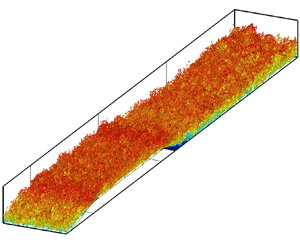Article contents
Outer layer turbulence dynamics in a high-Reynolds-number boundary layer up to  $Re_\theta \approx 24{,}000$ recovering from mild separation
$Re_\theta \approx 24{,}000$ recovering from mild separation
Published online by Cambridge University Press: 26 May 2022
Abstract

The outer layer dynamics of a high-Reynolds-number boundary layer recovering from non-equilibrium is studied utilising the multi-resolution approach of zonal detached eddy simulation mode 3. The non-equilibrium conditions are obtained from a boundary layer separation over a rounded step enhancing the turbulent production, and recovery happens during redevelopment after reattachment at high Reynolds numbers ( $Re_{\theta,max}\approx 24{,}000$). Most of the outer layer turbulence is resolved by the simulation, which reproduces accurately the experimental boundary layer relaxation. The spectral analysis of streamwise velocity fluctuations and turbulent kinetic energy (TKE) production evidences the different turbulent content distribution at separation and within the redevelopment region, at which very large-scale motions are identified with streamwise wavelengths up to
$Re_{\theta,max}\approx 24{,}000$). Most of the outer layer turbulence is resolved by the simulation, which reproduces accurately the experimental boundary layer relaxation. The spectral analysis of streamwise velocity fluctuations and turbulent kinetic energy (TKE) production evidences the different turbulent content distribution at separation and within the redevelopment region, at which very large-scale motions are identified with streamwise wavelengths up to  $\lambda _x = 9\delta$, where
$\lambda _x = 9\delta$, where  $\delta$ is the boundary layer thickness. The redevelopment of the boundary layer is analysed in terms of the persistence of a secondary peak in the TKE production and the evolution of the wall-shear stress statistics. The skewness and probability density function of the skin friction show a slower relaxation than the downstream flow fraction. This confirms the long-lasting impact of perturbations of the outer layer in high-Reynolds-number wall-bounded flows. This persistent non-equilibrium state is suggested to be the reason for the reported lack of accuracy of the considered Reynolds-averaged Navier–Stokes models in the relaxation region.
$\delta$ is the boundary layer thickness. The redevelopment of the boundary layer is analysed in terms of the persistence of a secondary peak in the TKE production and the evolution of the wall-shear stress statistics. The skewness and probability density function of the skin friction show a slower relaxation than the downstream flow fraction. This confirms the long-lasting impact of perturbations of the outer layer in high-Reynolds-number wall-bounded flows. This persistent non-equilibrium state is suggested to be the reason for the reported lack of accuracy of the considered Reynolds-averaged Navier–Stokes models in the relaxation region.
- Type
- JFM Papers
- Information
- Copyright
- © The Author(s), 2022. Published by Cambridge University Press
References
REFERENCES
- 4
- Cited by





